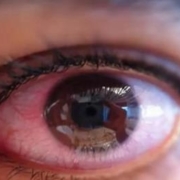What is uveitis?
Uveitis is a general term that refers to inflammation of the uvea, the middle layer of the eye that consists of the iris, ciliary body, and choroid.
Iritis, also known as anterior uveitis, is a specific type of uveitis that involves inflammation of the iris, the colored part of the eye that controls the amount of light entering the eye by adjusting the size of the pupil.
Symptoms of uveitis, including iritis, may include:
Eye redness
Eye pain
Light sensitivity (photophobia)
Blurred vision
Floaters (small moving spots in your field of vision)
Swelling around the eye
The exact cause of uveitis or iritis is often unclear but may be related to autoimmune disorders, infections, trauma, or exposure to toxins.
In some cases, it can be associated with systemic diseases such as rheumatoid arthritis, lupus, or sarcoidosis.
Diagnosis of uveitis or iritis typically involves a comprehensive eye examination, which may include a slit-lamp examination, ocular pressure measurement, and sometimes additional tests to rule out other potential causes or to identify underlying conditions.
Treatment for uveitis and iritis depends on the underlying cause and severity of the condition. It often includes corticosteroid eye drops to reduce inflammation, along with other medications to manage pain, dilate the pupil, or treat any underlying infection or systemic condition. In more severe cases, oral or injectable corticosteroids may be prescribed to manage inflammation. Treatment may also involve the use of immunosuppressive or biologic medications, especially if an autoimmune disorder is the underlying cause.
It is important to follow the prescribed treatment plan and attend follow-up appointments with your healthcare provider, as untreated uveitis or iritis can lead to complications such as glaucoma, cataracts, retinal detachment, or even permanent vision loss.
In addition to medical treatment, some general self-care measures can help alleviate symptoms and support the healing process:
Protect your eyes from direct sunlight by wearing sunglasses with UV protection.
Avoid eye strain by taking breaks when using a computer or other digital devices for extended periods.
Maintain good eye hygiene by washing your hands before touching your eyes and avoiding the use of eye makeup or contact lenses until the inflammation has resolved.
Follow your healthcare provider’s instructions on the use of medications and attend all follow-up appointments to monitor your progress and adjust treatment as needed.
Remember that early diagnosis and prompt treatment are crucial for preventing complications and preserving your vision. If you experience any symptoms of uveitis or iritis, it is important to consult an eye care professional promptly.
長庚醫院 林口醫學中心 眼科部部長 葡萄膜炎/虹彩炎/視網膜科 黃奕修 教授 執筆
醫學新知/最夯科技/訊息導正/連續照護/防盲責任
更多眼科資訊, 請見:
www.uveitis.tw / tois.tw / tus.tw 葡萄膜炎虹彩炎資訊網
www.dmeye.org 糖尿病眼病變資訊網
www.dreye.net 醫師的眼科醫師-眼科高端醫療資訊網
www.retina.tw 黃奕修醫師-視網膜病變資訊網




